As promised a few days ago, here’s a round up for Meeting of Styles in London last weekend. Really a top notch graffiti festival. Check out the flickr pool for more photos.
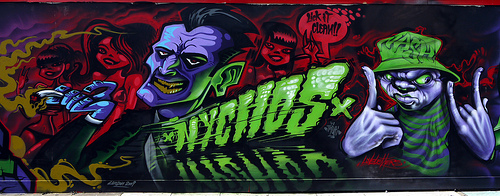
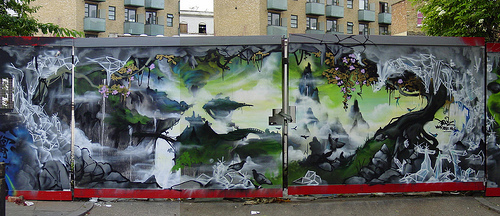
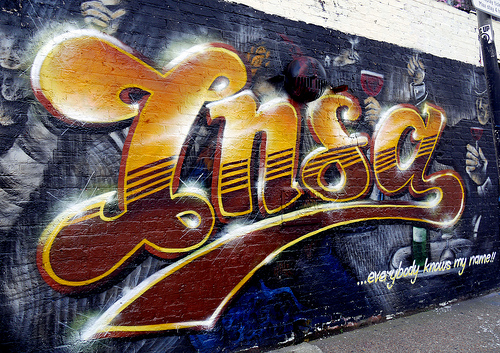


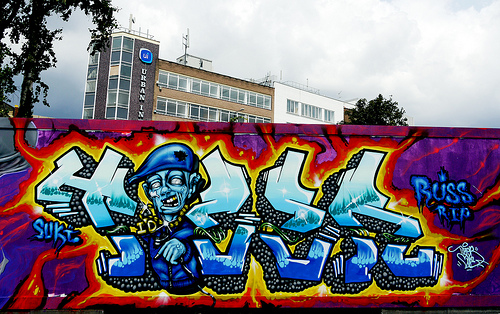


Photos by delete08 and nolionsinengland
As promised a few days ago, here’s a round up for Meeting of Styles in London last weekend. Really a top notch graffiti festival. Check out the flickr pool for more photos.








Photos by delete08 and nolionsinengland
Time Bomb at the Museum of Contemporary Art in Sydney is an interactive piece of graffiti. Film maker Lukasz Karluk (Holler) and artists KissKiss, DMOTE, Kid Zoom, Numskull, Ben Frost, Roach, John Doe, Bennet and Creon are involved in the work. What makes the project interactive, just watch the video to find out…
Via Artbleat
I touched on this issue the other day, but I thought there was more to be said and some examples to be given.
There are a few graffiti writers who are blurring the line between graffiti and street art by painting trademark characters or symbols instead of, or in addition to, their names. Of course, painting characters has been around since the earliest days of graffiti, but in recent years, certain crews and writers have taken that a step further.
Here are a few examples of writers who I think are really pioneering a new form of character based graffiti. I think it could, and should, be one important direction for graffiti and street art in the coming years.

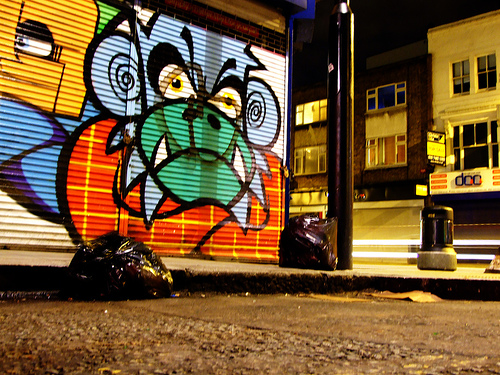
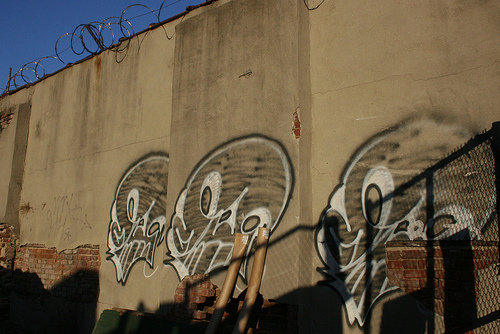
More after the jump… Continue reading “From letters to logos”
Admittedly, I’m not the most knowledgeable about graffiti, but occasionally I see a writer whose work I am very impressed by. One guy whose flickr I’ve been loving recently is Lush. Check out these pieces.
Photos by MercifulFate
About a month ago, I was in Baltimore and had a fascinating conversation with Gaia. We were debating which form or forms of government can best be used as an analogy to structure of the street art and graffiti worlds. The primary systems of government that we mentioned were democracy, autocracy/dictatorship, and anarchy.
Gaia’s post on the conversation went online a while ago and can be read on his blog. As Gaia notes, he believes that both street art and graffiti are inherently democratic. Artists and writers can put up their message and everybody has just as much right as anybody else to do so. I would add that this democracy also creates a general respect and understanding between those working on the street. For example, Barry McGee’s work is not going to be painted over because, as a group, artists and writers have given him a lot of respect. Similarly, it is generally understood within graffiti that there is a hierarchy of work, and that work of a higher complexity (pieces) can go over simpler work (tags, throw-ups…), and that hierarchy is upheld by consensus among writers. Gaia’s view seems to be the prevailing opinion among street artists, and many specifically talk about how the democracy of the street is what draws them to working in such a unique environment.
I held this view for a while as well. Then Brad Downey told me that he believes street art is the opposite of democracy. Essentially, his argument is that street art allows him or anybody else to do whatever they want, which isn’t democracy at all. And I’ve started to think he has a point. Maybe street art is more like anarchy.
In a democracy, everybody can voice their opinions, but their actions must ultimately be judged as acceptable or not by the masses. That means an artist could be reprimanded for his or her actions if they are against the general will of the other artists. While there are some unwritten rules of street art and artists might be frowned upon for breaking them, that’s about all the punishment they will get. As long as an artist is not afraid of people hating him, he could potentially claim that ripping up every Swoon wheatpaste in New York is his form of street art, and nobody could stop him no matter how upset they might be. On the street, artists can do pretty much anything they want.
Somebody’s going to point out that Gaia uses a different definition of democracy than I do. Well, we can still look at his definition (“a realm in which agonistic polemics and discourses can occur without suppression”) and see why it doesn’t fit with street art. Take a look at that last bit where it notes “without suppression.” Work gets painted over all the time, and that certainly seems to me like a form of suppression. While all fans of graffiti and street art must accept the ephemeral nature of the work, that generally implies that the work decays over time. On the contrary, work can be buffed or removed seconds after it is put up, and even within the community, many artists have no qualms about painting over other people’s work (and some even develop personal vendettas which play out as writing over/supressing brand new work – see 10 Foot). If that’s not suppression (particularly when it is done by fellow artists/writers), I don’t know what is.
Another potential system of government comparable to the street art and graffiti world might be a dictatorship. Particularly in the graffiti world, artists can get extremely hierarchical (can you believe I spelled that right on the first try?), and the kings have a good deal of power. Admittedly, I am not anywhere near as knowledgeable about graffiti as I am about street art, but as I understand it, not only is there the hierarchy I mentioned earlier with different types of pieces taking precedence over others, but the work of certain writers is left alone by all but the most bold up and coming writers. And unlike street art, when writers do break the rules, they get into actual fights about it (and no, street art’s flickr comment wars do not count).
This even crosses into street art a bit. The way that the street art community currently works, its existence is entirely dependent on passive acceptance by the graffiti community. All too often, street artists get their work intentionally written over with tags and graffiti, and the artists act as though they are honored that some writer is familiar enough with their work to write over it. If graffiti writers wanted to really put in the effort, they could virtually destroy a city’s street art scene.
10 Foot has shown this very well. Even though most artists are still trying to get up, it’s extremely rare to see certain artists whose work has not been tagged over by 10 Foot.
That’s not a dialog, it’s suppression.
The reality is though, no one of these systems can fully encapsulate what street art and graffiti are. I think it is more accurate to say that the correct analogy is whichever one the last person to get up was thinking of when they did their work. Some artists do work with the intent of creating a democratic dialog and respecting the work of others. Other artists just get up for themselves or to spread their message, disregarding the will of others. And many just paint to maintain a balance of power.
My French is pretty terrible (just got back from France, realized I couldn’t say much more than ‘merci’ after 9 months not taking the language at school), but what this video is still pretty cool, and I Love Graffiti was able to help sort out with the details about Le Tag.
Le Tag is an exhibit in Paris of graffti by 150 writers. It is currated by French architect Alain-Dominique Gallizia.
Artists in the exhibit include (and I can’t believe this first one) Taki 183, Seen, Doze Green, Phase2, and L’Atlas.
I know that in some ways Taki 183 is just one guy that the New York Times picked up on as an early tagger, but the article featuring him inspired so many people to start tagging, and he was one of the first to really get their name throughout New York City. I didn’t even realize he was still writing his name. The last I’d seen of Taki 183 was in Bomb It the movie, and he didn’t seem too interested in graffiti. Even though it’s “just a tag” and I really like Seen and some of the other artists in this show, Taki 183’s stuff is my personal highlight of Le Tag.
Le Tag runs until April 26. More at the official website.
Clever. The question is, did the owner do this, or is the box itself meant to be art as well. Oh who cares just check out this picture:
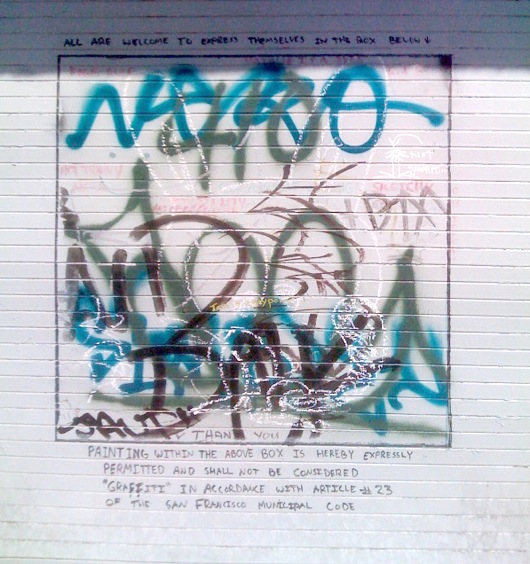
The text reads:
All are welcome to express themselves in the box below.
and
Painting within the above box is hereby expressly permitted and shall not be considered “graffiti” in accordance with article #23 of the San Francisco Municipal Code
Via Public Ad Campaign via Boing Boing
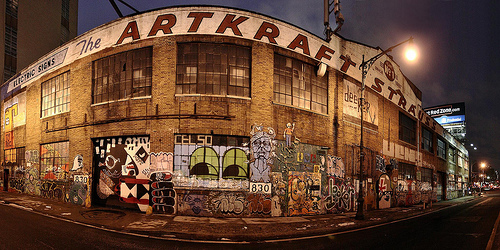
C-Monster has a very good post up about the NY Post‘s recent comments about a wall in the city well-known for its graffiti/street art. Naturally, they are not too happy that it exists. I’ve not seen this wall in person, but based on the above photo by f.trainer, it looks like one of the city’s treasures.